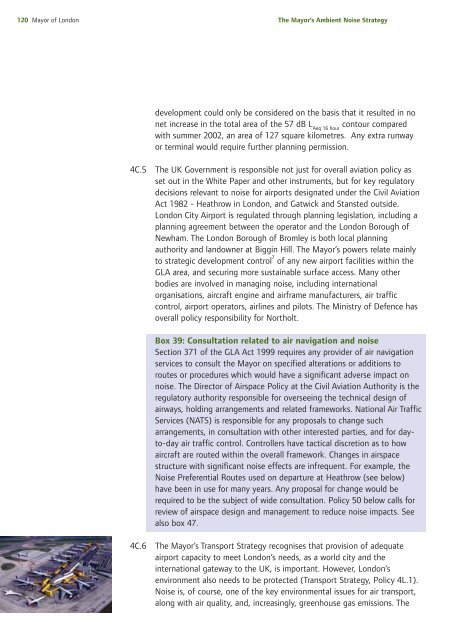The Mayor's Ambient Noise Strategy - Greater London Authority
The Mayor's Ambient Noise Strategy - Greater London Authority
The Mayor's Ambient Noise Strategy - Greater London Authority
You also want an ePaper? Increase the reach of your titles
YUMPU automatically turns print PDFs into web optimized ePapers that Google loves.
120 Mayor of <strong>London</strong><br />
<strong>The</strong> Mayor’s <strong>Ambient</strong> <strong>Noise</strong> <strong>Strategy</strong><br />
development could only be considered on the basis that it resulted in no<br />
net increase in the total area of the 57 dB L Aeq 16 hour<br />
contour compared<br />
with summer 2002, an area of 127 square kilometres. Any extra runway<br />
or terminal would require further planning permission.<br />
4C.5 <strong>The</strong> UK Government is responsible not just for overall aviation policy as<br />
set out in the White Paper and other instruments, but for key regulatory<br />
decisions relevant to noise for airports designated under the Civil Aviation<br />
Act 1982 - Heathrow in <strong>London</strong>, and Gatwick and Stansted outside.<br />
<strong>London</strong> City Airport is regulated through planning legislation, including a<br />
planning agreement between the operator and the <strong>London</strong> Borough of<br />
Newham. <strong>The</strong> <strong>London</strong> Borough of Bromley is both local planning<br />
authority and landowner at Biggin Hill. <strong>The</strong> Mayor’s powers relate mainly<br />
to strategic development control 7 of any new airport facilities within the<br />
GLA area, and securing more sustainable surface access. Many other<br />
bodies are involved in managing noise, including international<br />
organisations, aircraft engine and airframe manufacturers, air traffic<br />
control, airport operators, airlines and pilots. <strong>The</strong> Ministry of Defence has<br />
overall policy responsibility for Northolt.<br />
Box 39: Consultation related to air navigation and noise<br />
Section 371 of the GLA Act 1999 requires any provider of air navigation<br />
services to consult the Mayor on specified alterations or additions to<br />
routes or procedures which would have a significant adverse impact on<br />
noise. <strong>The</strong> Director of Airspace Policy at the Civil Aviation <strong>Authority</strong> is the<br />
regulatory authority responsible for overseeing the technical design of<br />
airways, holding arrangements and related frameworks. National Air Traffic<br />
Services (NATS) is responsible for any proposals to change such<br />
arrangements, in consultation with other interested parties, and for dayto-day<br />
air traffic control. Controllers have tactical discretion as to how<br />
aircraft are routed within the overall framework. Changes in airspace<br />
structure with significant noise effects are infrequent. For example, the<br />
<strong>Noise</strong> Preferential Routes used on departure at Heathrow (see below)<br />
have been in use for many years. Any proposal for change would be<br />
required to be the subject of wide consultation. Policy 50 below calls for<br />
review of airspace design and management to reduce noise impacts. See<br />
also box 47.<br />
4C.6 <strong>The</strong> Mayor’s Transport <strong>Strategy</strong> recognises that provision of adequate<br />
airport capacity to meet <strong>London</strong>’s needs, as a world city and the<br />
international gateway to the UK, is important. However, <strong>London</strong>’s<br />
environment also needs to be protected (Transport <strong>Strategy</strong>, Policy 4L.1).<br />
<strong>Noise</strong> is, of course, one of the key environmental issues for air transport,<br />
along with air quality, and, increasingly, greenhouse gas emissions. <strong>The</strong>
















